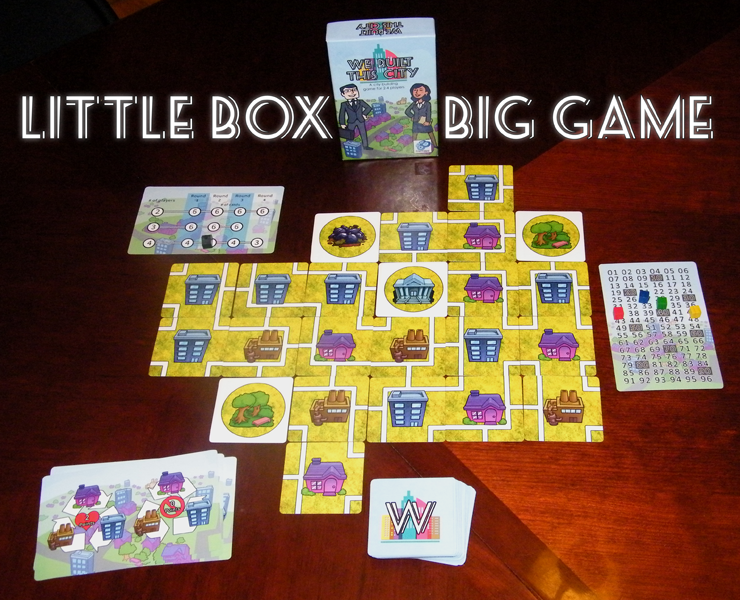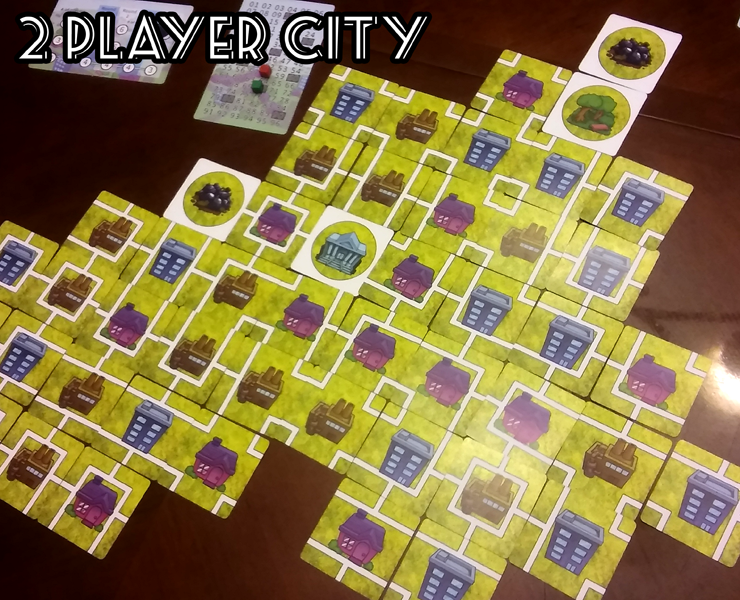What do you get when you combine the structures found in city-builders like “SimCity” with tile-laying mechanics as found in a game like “Carcassonne”? You end up with “We Built This City”, a game that rewards players points for the buildings they lay on a shared grid/city. It’s a bit like “Sunrise City”, albeit a simpler version (no bidding, etc.). Before we jump into the details, I’d like to quickly thank Mike McGinnis of Enigma Nexus for providing me with a free press copy for review purposes.
Components
The game includes 60 city cards, 1 city hall card, 28 markers in 4 colors, a white start player token, a black round marker, a round tracker, a score tracker, reminder cards, and a rule book.
Setup & Gameplay
Firstly, the city hall card is placed in the middle of the table. The remaining cards are shuffled to form a face-down draw pile. Each player chooses a color and receives seven markers of that color, assigning one to the score track. They also receive a quick reference card. The black marker is placed on the round one space on the appropriate track (2 players, 3 players, or 4 players). A starting player is chosen at random.
The game is played over four rounds (three for three players). At the beginning of every round, players draw a number of cards equal to the value shown on the round tracker. The first player takes their turn, with the other players proceeding clockwise until they are all out of cards. On a player’s turn, they’ll play a single card onto the grid (placing one of their markers onto it) within accordance to the tile placement rules:
1. Cards must be placed to an existing card.
2. The roads must align/connect on each side when appropriate. The city hall, park, and dump cards don’t have roads and ignore this rule.
3. All cards must be oriented in the same direction as the city hall.
At the end of the round, players remove their markers one at a time, scoring each tile as they do so and adjusting the score tracker appropriately. A card scores one point for each card of the same kind bordering it. The rest of scoring is done in a rock-paper-scissors fashion…that is, houses get zero points from factories but two points from offices, and so on. Parks are worth one point to every card it touches and the player who places it earns two points. Dumps are worth zero points to the player who places it and any card adjacent to one is worth zero points. Regardless of all of the above, a card is not worth anything if it is not connected to the city hall via road.
The player with the most points at the end of the game is the winner!
Editor’s Note: The above doesn’t cover all of the rules found in the manual, but should give you an idea as to how the game is played.
The Review
I have to say, it was extremely difficult to write this review. The game wasn’t hard to figure out or anything like that, I just had a bad habit of reciting lyrics from the song of the same name (by “Starship”) whilst in the middle of typing a sentence. Imagine how annoying it is trying to write about residential zones only to accidentally end your thought/sentence with the words “rock and roll”. From an SEO point of view, I probably would have named the game something a bit more unique…no seriously, type in “We Built This City” into Google and let me know if you find the game instead of the song.
Luckily, I’m not here to critique a game’s SEO effectiveness…Rajesh Kaheem Babar no doubt has that covered (based on the endless amount of emails I get regarding that subject). Rather, I’m more interested in discussing the game itself and I have to say, I enjoyed it. The hardest part, I felt, was keeping in mind the “rock-paper-scissors” effect the houses, offices, and factories had on one another with regard to points/end of round scoring. While part of me wanted to concentrate on building up in one direction to ensure that my buildings were connected via road to the town hall (otherwise they’d be worth zero points), I had to remember to spread out a bit to avoid being slammed by the dump card, which effectively reduces any adjacent cards to zero points. The process of growing this shared city turned out to be a tough but fun balancing act.
If I were to compare this to other games on the market, I’d have to say that it closely resembles “Sunrise City” but on a much lighter scale. It’s like “Sunrise City” in the sense that you’re collectively building up a shared city with tiles, however there’s no bidding, special roles/abilities, or building floors. This is fine by me and I appreciate that there’s a game similar to “Sunrise City” out there that I can play in about thirty minutes (“Sunrise City” takes a bit longer). While fairly simple to play, it packs enough of a strategic punch to keep players engaged and thinking about their next move. It’s very easy to get so caught up in your own hand that you forget that you can play off of tiles that your opponents are laying down. I also like how both the dump and park cards spiced things up, especially how the former can instantly change the look on someone else’s face from smugness to sorrow.
Overall I was extremely impressed with this one. No longer do I have to pull my hair out trying to tie tile effects together in “Suburbia” in order to get my city-builder fix. The components are not only good and colorful, but baggies were included (which is always a plus with me). This is one light city-builder that you won’t want to miss.
Final Verdict: 9/10
—
You can learn more about and purchase “We Built This City” by visiting the game’s page on The Game Crafter, here:
https://www.thegamecrafter.com/games/we-built-this-city
—


